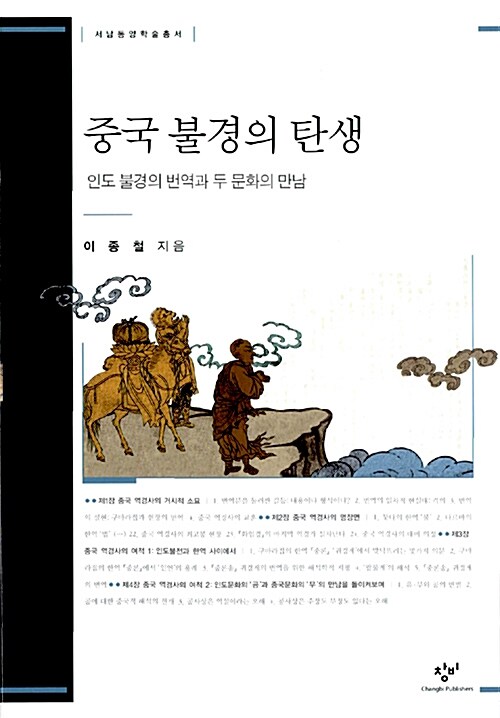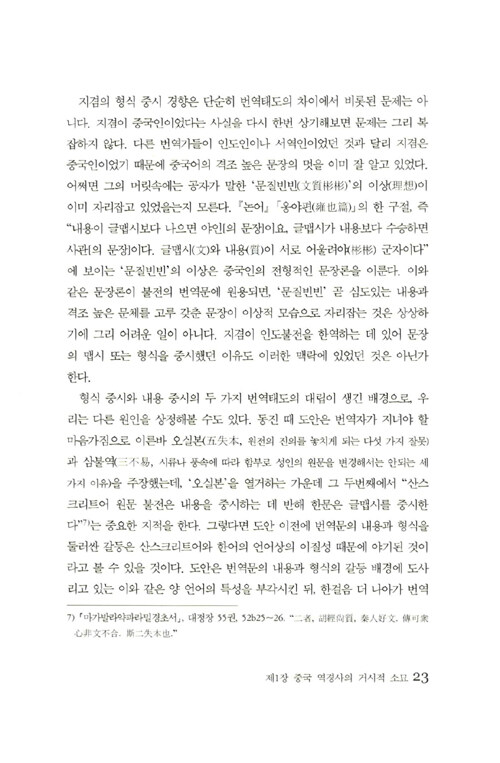중국 불경의 탄생 - 인도 불경의 번역과 두 문화의 만남
이종철 (지은이)창비2008-04-30






















정가
17,000원
기본정보
양장본
236쪽
책소개
중국 후한부터 송대까지 산스크리트어 불경을 번역한 한역불전(漢譯佛典) 역경가들의 생애와 번역 작업을 복원하고, 그들의 번역이 중국에 끼친 사상사.문화사적 영향을 살핀다. 더불어 동아시아 불교사상 형성에 기틀이 된 핵심개념들의 창조적 변용을 논구한다.
목차
서남동양학술총서 간행사| 21세기에 다시 쓴 간행사
책머리에|동아시아의 문화적 용광로,한역불전
제1장 중국 역경사의 거시적 소묘
1.번역문을 둘러싼 갈등:내용이냐 형식이냐?
2.번역의 일차적 현실태:격의(格義)
3.번역의 실현:구마라집과 현장의 번역
4.중국 역경사의 교훈
제2장 중국 역경사의 명장면
1.붓다(buddha)의 한역 '불(佛)'
2.다르마(dharma)의 한역 '법(法)'
3.상가(samgha)의 한역 '승(僧)'
4.수수께끼의 첫 한역 『사십이장경』
5.중국 역경사의 효시 안세고
6.대승경전의 첫 역경가 지루가참
7.삼국시대의 역경작업:오나라의 '지혜주머니'지겸과 강남불교의 홍륭자 강승희
8.양진시대 불교계의 동향
9.위진현학과 불교
10.서진의 '돈황보살'축법호
11.오호십육국시대의 '대화상'불도징:불교와 민족
12.중국 역경사의 길잡이 도안
13.중국 역경사의 첫 분수령 구마라집
14.구마라집의 문하:승조와 축도생
15.북량의 비운의 역경가 담무참
16.남북조시대 불교계의 동향
17.남조의 '마하연'구나발타라
18.북조의 '역경 원장(元匠)'보리류지
19.남조의 유랑(流浪)의 역경가 진제
20.남북조시대 유식사상의 과제:알라야식과 아밀라식
21.수·당시대 불교계의 동향
22.중국 역경사의 최고봉 현장
23.『화엄경』의 마지막 역경가 실차난타
24.중국 역경사의 대미(大尾)의정
제3장 중국 역경사의 여적(餘適) 1:인도불전과 한역 사이에서
1.구마라집의 한역 『중론』'귀경게'에서 맞닥뜨리는 몇가지 의문
2.구마라집의 한역 『중론』에서 '인연(因緣)'의 용례
3.『중론송』귀경게의 번역을 우한 해석학적 지평
4.'팔불게(八不偈)'의 해석
제4장 중국 역경사의 여적(餘適) 2
:인도문화의 '공(空)'과 중국문화의 '무(無)'의 만남을 돌이켜보며
1.유(有)·무(無)와 공(空)의 변별
2.공(空)에 대한 중국적 해석의 전개
3.공사상은 역설이라는 오해
4.공사상은 주장도 부정도 없다는 오해
맺음말
참고문헌
찾아보기|인명
찾아보기|책명
찾아보기|용어
접기
책속에서
종파의 대두와도 연관되는 현상이겠지만, 경제적.정신적 자신감을 갖게 되면서 수.당 불교계는 인도불교의 산스크리트어 원전에 대한 태도 및 역경작업에 대한 태도에 큰 변화를 보인다. 곧 인도불전의 원래의 의미를 깊이 좀더 깊이 끝없이 캐묻는 모범생적인 태도보다는 이미 중국어로 번역된 불전에 대해서 중국어로 주석하거나 해석하면서 나름대... 더보기
저자 및 역자소개
이종철 (지은이)
저자파일
신간알리미 신청
한국학한국학중앙연구원 한국학대학원 철학(불교철학) 전공 교수. 서울대학교 철학과를 졸업하고 일본 도쿄대학교에서 인도철학·불교학으로 석사학위와 박사학위를 받았다. 동아시아 불교사상과 인도 불교사상의 비교연구에 주력하고 있다. 주요 논저로 The Tibetan Text of the Vy?khy?yukti of Vasubandhu-Critically edited from the Cone, Derge, Narthang and Peking editions-(Tokyo, 2001), 『世親思想の硏究-釋軌論(Vy?khy?yukti)を中心として-... 더보기
최근작 : <圓測 『解深密經疏』 <無自性相品>>,<圓測 『解深密經疏』 <地波羅蜜多品>>,<원측 해심밀경소 분별유가품 - 한장교감 표점 교정본> … 총 15종 (모두보기)
출판사 소개
창비
도서 모두보기
신간알리미 신청

최근작 : <민족문학의 새 단계: 민족문학과 세계문학 3>,<민족문학의 현단계: 민족문학과 세계문학 2>,<살까? 말까?>등 총 2,866종
대표분야 : 국내창작동화 1위 (브랜드 지수 2,546,645점), 청소년 소설 1위 (브랜드 지수 1,152,874점), 여성학/젠더 1위 (브랜드 지수 161,658점)
출판사 제공
책소개
중국 후한부터 송대까지 산스크리트어 불경을 번역한 한역불전(漢譯佛典) 역경가들의 생애와 번역 작업을 복원하고, 그들의 번역이 중국에 끼친 사상사·문화사적 영향을 살펴보는 책이다. 당시의 역경가가 번역 과정에서 고투했을 번역어의 할당 문제, 번역 과정에서 고안해낸 나름의 번역 이론을 소개하고, 동아시아 불교사상 형성에 기틀이 된 핵심개념들의 창조적 변용을 논구한다.
동아시아의 문화적 용광로, 한역불전
중국에 불교가 전해진 때는 대략 1세기 전후로 보지만, 그 본격적인 전래는 2세기 중반 인도 불전의 한역(漢譯)이 시작되는 시점으로 잡는 것이 보통이다. 그후 1,000년에 걸쳐 이루어지는 한역은 그 과정 자체가 동아시아 불교사상의 심화이자 인도와 중국 두 문화의 지성사적 충돌과 원융의 용광로였다. 산스크리트어 불전에 나타나는 일군의 개념어들은 한역불전을 지식의 원천으로 삼아 새롭게 자신의 사상을 형성한 동아시아 불교사상가들의 핵심개념과 중요한 연결고리를 형성한다. 서양 기원전후의 그리스어와 아랍어 번역, 르네쌍스의 라틴어 고전 부활, 계몽시대 자국어 성서 운동이 보여주듯 고전과 경전의 번역은 국가 차원의 프로젝트였다. 동아시아에서는 5~9세기 장안(長安)과 개화기 일본의 번역 사업이 좋은 예인데, 그 뿌리에는 한역불전의 유구한 전통이 있다.
직역이냐 의역이냐를 둘러싼 경전의 번역논쟁
인도 불전의 역경사는 구마라집과 현장을 두 분기점으로, 고역(古譯)·구역(舊譯)·신역(新譯) 세 시기로 나뉜다. 고역기는 인도 불전의 꾸밈없는 직역이 중시되었다. 초기의 번역가들이 대개 인도인 또는 서역인이었기 때문에 격조 높은 한문을 구사할 수 없는 사정도 있었다. 점차 중국인 역경가들이 나오면서 주요 개념어를 한자로 음사(音寫)하는 수준에서 벗어나 내용과 문체를 고루 갖춘 역경에 대한 요구가 거세졌다. 이러한 요구는 동진시대 들어 불교 이해에 ‘해석학적 방법’을 도입하는 계기가 되었다. 그리하여 중국고전, 특히 노장사상의 술어를 다수 끌어들여 그것에 빗대 원문의 뜻을 해설하는 ‘격의(格義)’ 방식이 두드러졌다. 하지만 이 또한 경전의 진의를 해치고 천박한 이해로 끌어내리는 우를 범하는 때가 많았다. 이런 과정을 거치면서 격의가 단순히 낯선 것과 익숙한 것의 일대일 치환이 아니라 의미의 심층으로 내려가는 도구가 되는 ‘해석학적 사다리’가 되어야 한다는 합의에 도달했다.
텍스트의 성격에 따른 상이한 번역 태도
인도 출신의 역경가 구마라집의 출현으로 고역기가 끝나고 구역기가 시작된다. 포교를 중시한 구마라집은 거의 창작에 가까운 의역을 구사했다. 그의 작업 방식은 역장(譯場)에서 설법을 병행하는 식이었으며 많은 중국인 제자의 조력을 받았다. 구역기를 마치고 신역기를 연 현장은 구마라집과 달리 직역의 가치를 높이 보고 좀더 섬세한 기술적 접근을 꾀했으며, 주로 철학적 논서에 탁월했다. 현장의 번역으로 기존 중국의 관념어에 새로운 어휘가 보태지고 한자문화권의 사유지평이 확대되었다. 대중을 상대로 한 대승경전과 철학적 요소가 강한 논서에 각기 다르게 적용된 번역 태도는 지금의 번역에도 시사하는 바가 크다고 하겠다. 이밖에도 이 책은 당대 최고의 사상가·문필가였던 역경고승 20여명의 생애와 번역 과정의 고투를 통해 동아시아 불교사상의 거대한 흐름을 압축적으로 드러낸다.
인도의 ‘공(空)’과 중국의 ‘무(無)’
번역어의 변천은 문헌사적 문제를 넘어 상이한 문화의 수용·변용이라는 거대담론의 주제로 확장된다. 고역기의 번역어 ‘무(無)’가 구마라집에 의해 ‘공(空)’으로 대체되기까지의 200년은 기존의 의미틀을 부수고 새로운 해석학적 지평을 연 상징적 사건이자 중국을 중심으로 한자문화권의 독자적 불교사상·문화가 피어나는 성장기였다. 이후 중국에서는 ‘종파불교’가 세차게 전개되고 삼론종, 천태종, 화엄종 등 절충의 노력이 있었지만 결국 선불교가 종착역이 되었다. 저자는 이같은 중국불교의 창조적 변용과 재해석에 큰 의미를 두면서도 또한 서로 다른 문화의 대화 가능성과 보편적 생활세계의 객관성을 모색하는 교훈으로 삼자고 제안한다. 접기
북플 bookple
이 책의 마니아가 남긴 글
친구가 남긴 글
내가 남긴 글
친구가 남긴 글이 아직 없습니다.
마니아
읽고 싶어요 (2)
읽고 있어요 (0)
읽었어요 (3)
이 책 어때요?
구매자 분포

0% 10대

0.4%

2.6% 20대

5.7%

9.6% 30대

13.6%

9.2% 40대

30.7%

8.3% 50대

14.5%

3.1% 60대

2.2%
여성 남성
100자평
등록
카테고리
글 작성 유의사항
구매자 (0)
전체 (0)
공감순

등록된 100자평이 없습니다.
마이리뷰
구매자 (0)
전체 (0)
리뷰쓰기
공감순

등록된 리뷰가 없습니다.
마이페이퍼
전체 (1)
페이퍼 쓰기
좋아요순

불교경전의 종류와 구분
불교경전의 종류와 구분
불교 경전은 크게 두 종류로 구분한다. 원시불경(초기불경)과 소승과 대승으로 구분되 이후 텍스트를 중요시하는 대승불경으로 나눈다.
원시불경은 부처의 가르침을 직접 받아 적거나 당대의 가르침들이 다수 포함되어 있는 경우다. 원시 불경에는아함경(阿含經), 열반경, 범망경, 법구경, 숫타니파타, 자타카, 백유경, 부모은중경, 유교경, 미린다왕문경 등이 있다.
대승경전
대품반야경 소품대양경, 대반양경, 반야심경, 금강경, 법화경,관음경, 무량의경, 유마경, 화엄경, 무량수경, 관무량수경, 아미타경 등이 있다.
이 외에도 정토, 밀교와 관련되 불경들이 있다. 해인사에 있는 팔만대장경은 다수의 불경들을 집대성한 것이다. 현재 전산화를 모두 마친 상태이다.
불경란 무엇인가?
불경은 일차적으로 부처의 말씀이다. 더 넓은 의미로는 부처의 제자들의 말씀도 포함한다. 이후 소승불교와 대승불교로 나누어지면서 문자를 중요시하는 대승불교에서는 자기들만의 가르침을 설파하기 위한 수트라 즉 경을 만들었다. 대승불교의 경전들은 부처의 직접적인 말씀이나 직계제자들의 가르침이 아니기 때문에 불경이 아니라고 주장하는 사람들도 있다. 그러나 부처의 가르침을 확장시켰다는 의미에서 불경으로 받아 들인다.
불교에서 경전을 팔만사천법문이라고도 부른다. 여기서 팔만사천은 실수가 아닌 무수 즉 많으므로 없다는 뜻이다. 이것은 인간의 생로병사에 과련된 애환과 아픔이 팔만사천 처럼 셀수도 헤라릴 수도 없다는 뜻이고, 이에대한 부처의 가르침 역시 헤아릴 수 없다는 뜻에서 팔만사천문이라고 부른다. 해운사에 있는 고려대장경 역시 팔만여장에 가까운데 이것은 그만큼 많은 이야기를 담고 있다는 뜻이기도 하다.
불경의 언어
부처는 제자들에게 자신의 가르침을 모든 사람들이 듣고 쉽게 이해할 수 있도록 일상어로 전하라고 했다. 당시 흔히 사용하던 언어는 마가다어였다고 한다. 부처가 입멸한 뒤 불법은 다시 팔리어로 전래 되었다. 그러나 입멸후 2-3세기가 지나면서 불경은 산스크리트어로 전래 된다. 산스크리트어는 전문가들의 언어이다. 이후로 불경은 평민들에는 쉽게 접근할 수 없는 고립된 가르침으로 남게 된다. 이 때를 기준으로 대승불교가 확연하게 생겨나게 되었고, 학문적이고 교리적인 가르침으로 굳어지게 된 것이다.
남방으로 전해진 불경은 보수적이고 전통적인 측면이 강해 팔리어 경전으로 아직도 그대로 사용하고 있다. 그러나 인도를 넘어 서북과 북쪽으로 전파된 북방불교의 경우는 자신의 언어와 현대적 언어로 변환시켜 번역했다. 현재 우리나라나 일본 중국등은 북방불교의 영향을 받은 것이고 이로 인해 직역이 아닌 그나라의 문화과 언어로 의역된 불경을 소지하고 있는 셈이다.
불경의 역사를 살펴보면 기독교의 성경의 역사와 너무 흡사하다는 생각이 든다. 성경도 초기에는 아람어로 예수님이 설교한 것을 제자들이 대중적인 언어인 헬라어로 기록한다. 성경에 사용된 헬라어는 일반인들이 사용하는 코이네 헬라어이다. 이후 성경이 교리적이고 체계적이 되면서 성경 원전은 그대로 보존되지만 교리적인 주석서들이 대거 편찬되면서 기독교의 화석화가 이루어진다. 중세의 기독교는 권력과 타협하여 철저하게 대중들로부터 고립되었으며, 라틴어로 번역되어 사제들에 의해서만 설교되고 가르치게 된다. 아직도 천주교는 이러한 전통을 따르고 있으며, 불과 얼마 전에 교인들도 성경을 읽도록 허락해 주었다.
- 접기
낭만인생 2012-04-15 공감 (34) 댓글 (1)
Thanks to
공감
찜하기

